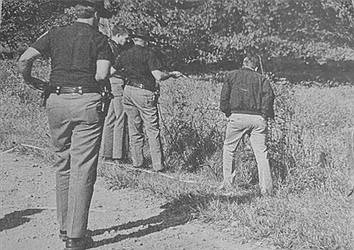FCRC looks to future projects
May 3, 2023 at 2:35 p.m.
The role of Franklin County Redevelopment Commission with upcoming area projects looks to be increasing in importance based on a 90-minute-plus meeting April 25 and outlook for the rest of the calendar year.
Whether financial commitments or administrative processes, the 5-person board will have plenty to consider as 2023 moves along.
Old business took up the biggest portion of Tuesday’s meeting, the one item being FCRC’s commitment to fund school corporation projects from revenue captured in the county’s Golden Road TIF (Tax Increment Financing) district specifically. FC commissioners signed an ordinance last July to permit 15% of said revenue each year going to FC Community School Corporation.
Sara Duffy, nonvoting liaison for FC schools, explained further.
“FCCSC) was locked into whatever they were getting before the TIF district was established,”she said, referring to property tax revenue. “They don’t get expansion or growth. Indiana Code opens the door to schools getting 15%.”
Nick Lawrence of The Wheatley Group (economic development consultant) attended, going back further by saying this type of financial pact was part of the establishing ordinance for FCRC. Any amendments since, then, go right along with amendments made at the time of establishment. He added he’s not seen one with county commissioner involvement; typically, it will be a funding agreement between redevelopment and the schools.
Member Brian Patterson agreed it should be between those two entities while cohort Tim George wondered why the commissioners were involved at all considering they appoint much of the redevelopment commission.
Patterson suggested removing “ordinance”and “commissioners”from the legal wording and replacing those with “funding agreement”and “FCRC.”
“This is an agreement between the (schools) and this board that handles money …that’s why they put us here,”he said.
“You want to give both sides as much flexibility as possible because the idea is to be successful,”added Lawrence.
Having options rather than a fixed 15% was also a point of discussion. President Bill Schirmer said language of “up to”15% was questioned. He preferred some wiggle room in case there was an opportunity presented to the school corporation that required quick action or negotiation versus waiting for year-end tax numbers.
“A customer may say it’s a million dollars for infrastructure, we could go back to the school board and say we need to take advantage of this,”said Schirmer. “t says ‘up to’15%? Let’s do 5%.”
Schirmer and Duffy had both spoken with Superintendent Tammy Chavis on the matter, though each had different takeaways from those conversations.
Schirmer relayed that she seemed to be fine with the “up to”amendment; Duffy, however, indicated that the superintendent and board wanted exactly what commissioners approved last summer and no qualifying language. Vice-president John Palmer reiterated that the commissioners’original approval was for 15% with the understanding redevelopment was to annually review funding requests from the schools.
Duffy recommended wording that gave the school board leeway to vote on a number between zero and 15%, then pass that decision on to commissioners. She prefers precise language. Duffy also wanted preciseness on when payments begin. In previous meetings, it was stated payment would be made in arrears based on revenue totals from the prior year (for instance captured 2022, paid 2023).
There’s a sense of urgency with helping the schools, due to a marketing campaign –spearheaded by Schirmer along with a steering committee –already approved by the school board with the goal of increasing student enrollment. A fund held by Franklin County Community Foundation with support from other entities will help kickstart the campaign. The committee includes Chavis, FCHS Principal Michelle South, Shelley Lunsford of FCCF and FC alums Brandon Ball and Gage Pace, with outside consultants in the mix.
Schirmer wished to request $10,000 up front from FCRC –more than 15% revenue –due to no official deal being in place yet. The payment in arrears could start later.
Member Derrike Kolb opined a marketing campaign won’t do anything for the schools; “I don’t see it.” Patterson requested a professional presentation at a future meeting that would help convince the board it’s a worthy project. Schirmer said Ball and possibly Lunsford could provide that.
Meanwhile, the payment’s on hold as the agreement’s wording is finalized.
There were a few items under new business.
The Sycamore gas line is installed on North SR 101 with redevelopment on the hook for $125,000 of total cost. A motion was approved to pay that once a bill is received.
Two other discussions were more to keep the board aware of things that may pop up on the agenda soon.
For years, Schirmer said there have been efforts to get sufficient water to the Southgate Industrial Park on SR 1 (Brackney) for fire suppression. A READI project (Regional Economic and Acceleration Development Initiative) is in the works for Dearborn County water to extend a 12-inch line from the county line north into Franklin County –hopefully as far as Brackney’s. In a different phase of the project, $2.9 million was requested from Southeast Indiana READI. The group wanted to see how the bids came back first.
As a result of lower bids, there was roughly $721,000 back on the table. Dearborn thought it could be used in its own county, but SEI READI insisted on using the funds to get water to Southgate. If it doesn’t extend that far based on $721K, options are to use fire hydrants or have FC cover the financial shortfall to finish the project. Lawrence advised against a bond due to its being a relatively low amount.
Another SEI READI project - sewer line extension up Reservoir hill to support housing development –is expected to involve FCRC in establishing a new residential TIF district north of Brookville.
Schirmer said that needs to be accomplished by Dec. 31, 2023; Lawrence confirmed, saying that would get “in front”of any economic development the county wants to establish in that area. The consultant added it would be safe to err on the side of 120 days to advertise and notify the public of the new TIF area. Lawrence spoke of a bill (HB 1005) in the Indiana General Assembly that had several components related to affordable housing in rural communities.
Briefly discussed was the second round of READI funds (Indiana-funded) attached to the IGA’s budget bill. Another $500 million will be made available in what Lawrence said is called the Capital Collaborative Communities program.
In financials, the Golden Rd. TIF was at $289,449 while operational fund was $45,373.33.
Latest News
E-Editions
Events
The role of Franklin County Redevelopment Commission with upcoming area projects looks to be increasing in importance based on a 90-minute-plus meeting April 25 and outlook for the rest of the calendar year.
Whether financial commitments or administrative processes, the 5-person board will have plenty to consider as 2023 moves along.
Old business took up the biggest portion of Tuesday’s meeting, the one item being FCRC’s commitment to fund school corporation projects from revenue captured in the county’s Golden Road TIF (Tax Increment Financing) district specifically. FC commissioners signed an ordinance last July to permit 15% of said revenue each year going to FC Community School Corporation.
Sara Duffy, nonvoting liaison for FC schools, explained further.
“FCCSC) was locked into whatever they were getting before the TIF district was established,”she said, referring to property tax revenue. “They don’t get expansion or growth. Indiana Code opens the door to schools getting 15%.”
Nick Lawrence of The Wheatley Group (economic development consultant) attended, going back further by saying this type of financial pact was part of the establishing ordinance for FCRC. Any amendments since, then, go right along with amendments made at the time of establishment. He added he’s not seen one with county commissioner involvement; typically, it will be a funding agreement between redevelopment and the schools.
Member Brian Patterson agreed it should be between those two entities while cohort Tim George wondered why the commissioners were involved at all considering they appoint much of the redevelopment commission.
Patterson suggested removing “ordinance”and “commissioners”from the legal wording and replacing those with “funding agreement”and “FCRC.”
“This is an agreement between the (schools) and this board that handles money …that’s why they put us here,”he said.
“You want to give both sides as much flexibility as possible because the idea is to be successful,”added Lawrence.
Having options rather than a fixed 15% was also a point of discussion. President Bill Schirmer said language of “up to”15% was questioned. He preferred some wiggle room in case there was an opportunity presented to the school corporation that required quick action or negotiation versus waiting for year-end tax numbers.
“A customer may say it’s a million dollars for infrastructure, we could go back to the school board and say we need to take advantage of this,”said Schirmer. “t says ‘up to’15%? Let’s do 5%.”
Schirmer and Duffy had both spoken with Superintendent Tammy Chavis on the matter, though each had different takeaways from those conversations.
Schirmer relayed that she seemed to be fine with the “up to”amendment; Duffy, however, indicated that the superintendent and board wanted exactly what commissioners approved last summer and no qualifying language. Vice-president John Palmer reiterated that the commissioners’original approval was for 15% with the understanding redevelopment was to annually review funding requests from the schools.
Duffy recommended wording that gave the school board leeway to vote on a number between zero and 15%, then pass that decision on to commissioners. She prefers precise language. Duffy also wanted preciseness on when payments begin. In previous meetings, it was stated payment would be made in arrears based on revenue totals from the prior year (for instance captured 2022, paid 2023).
There’s a sense of urgency with helping the schools, due to a marketing campaign –spearheaded by Schirmer along with a steering committee –already approved by the school board with the goal of increasing student enrollment. A fund held by Franklin County Community Foundation with support from other entities will help kickstart the campaign. The committee includes Chavis, FCHS Principal Michelle South, Shelley Lunsford of FCCF and FC alums Brandon Ball and Gage Pace, with outside consultants in the mix.
Schirmer wished to request $10,000 up front from FCRC –more than 15% revenue –due to no official deal being in place yet. The payment in arrears could start later.
Member Derrike Kolb opined a marketing campaign won’t do anything for the schools; “I don’t see it.” Patterson requested a professional presentation at a future meeting that would help convince the board it’s a worthy project. Schirmer said Ball and possibly Lunsford could provide that.
Meanwhile, the payment’s on hold as the agreement’s wording is finalized.
There were a few items under new business.
The Sycamore gas line is installed on North SR 101 with redevelopment on the hook for $125,000 of total cost. A motion was approved to pay that once a bill is received.
Two other discussions were more to keep the board aware of things that may pop up on the agenda soon.
For years, Schirmer said there have been efforts to get sufficient water to the Southgate Industrial Park on SR 1 (Brackney) for fire suppression. A READI project (Regional Economic and Acceleration Development Initiative) is in the works for Dearborn County water to extend a 12-inch line from the county line north into Franklin County –hopefully as far as Brackney’s. In a different phase of the project, $2.9 million was requested from Southeast Indiana READI. The group wanted to see how the bids came back first.
As a result of lower bids, there was roughly $721,000 back on the table. Dearborn thought it could be used in its own county, but SEI READI insisted on using the funds to get water to Southgate. If it doesn’t extend that far based on $721K, options are to use fire hydrants or have FC cover the financial shortfall to finish the project. Lawrence advised against a bond due to its being a relatively low amount.
Another SEI READI project - sewer line extension up Reservoir hill to support housing development –is expected to involve FCRC in establishing a new residential TIF district north of Brookville.
Schirmer said that needs to be accomplished by Dec. 31, 2023; Lawrence confirmed, saying that would get “in front”of any economic development the county wants to establish in that area. The consultant added it would be safe to err on the side of 120 days to advertise and notify the public of the new TIF area. Lawrence spoke of a bill (HB 1005) in the Indiana General Assembly that had several components related to affordable housing in rural communities.
Briefly discussed was the second round of READI funds (Indiana-funded) attached to the IGA’s budget bill. Another $500 million will be made available in what Lawrence said is called the Capital Collaborative Communities program.
In financials, the Golden Rd. TIF was at $289,449 while operational fund was $45,373.33.





